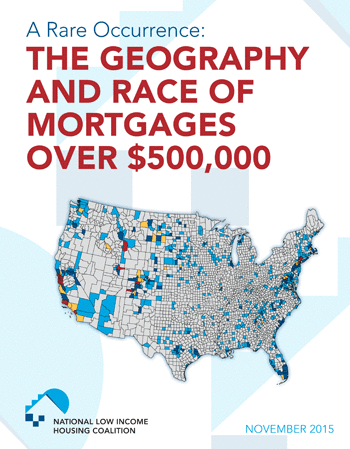 A study released today by NLIHC, A Rare Occurrence: The Geography and Race of Mortgages Over $500,000, finds that only 5% of new mortgages obtained in the past three years were larger than $500,000. Mortgages of this size are rare in most areas of the country, with most of them concentrated in high cost housing markets. In 40 states, fewer than 3% of new mortgages were larger than $500,000, and in 19 states such mortgages were less than 1% of those obtained in the state. Nationally, only 1.8% of black borrowers and 2.4% of Hispanic borrowers obtained mortgages larger than $500,000 in the past three years, compared to 4.4% for white borrowers.
A study released today by NLIHC, A Rare Occurrence: The Geography and Race of Mortgages Over $500,000, finds that only 5% of new mortgages obtained in the past three years were larger than $500,000. Mortgages of this size are rare in most areas of the country, with most of them concentrated in high cost housing markets. In 40 states, fewer than 3% of new mortgages were larger than $500,000, and in 19 states such mortgages were less than 1% of those obtained in the state. Nationally, only 1.8% of black borrowers and 2.4% of Hispanic borrowers obtained mortgages larger than $500,000 in the past three years, compared to 4.4% for white borrowers.
Current law allows taxpayers with mortgages to deduct the interest on mortgages of up to $1,000,000, plus an additional $100,000 in home equity loans. The United for Homes Campaign, led by NLIHC, has called for lowering the cap to the first $500,000 of a mortgage, converting the deduction to a 15 percent non-refundable tax credit, and directing the savings from these changes to fund the National Housing Trust Fund (NHTF). A preliminary analysis conducted for NLIHC by the Tax Policy Center shows that the two changes phased in over five years would generate $213 billion over ten years. Lowering the cap alone would produce $95 billion in new revenue over ten years.
NLIHC examined Home Mortgage Disclosure Act (HMDA) data from 2012, 2013, and 2014 to learn where mortgages over $500,000 are obtained and who obtains them. Only 48 counties had more than 10% of their mortgages larger than $500,000. Thirty-nine of these were metropolitan counties in high cost housing markets, including in Northern and Southern California, the New York City metropolitan area, the Washington, DC metropolitan area, Hawaii, two counties in the Boston metropolitan area, and one in the Seattle metropolitan area. The other nine were non-metropolitan counties home to well-known vacation destinations. These forty-eight counties, or just 1.5% of the 3,143 counties in the U.S., accounted for 67.4% of all mortgages over $500,000.
Nationally, while just 4.4% of all white borrowers obtained mortgages over $500,000, they were 2.5 times more likely than black borrowers to obtain such a mortgage and twice as likely as Hispanic borrowers. In states with a high proportion of black borrowers, white borrowers were from 1.6 (New York) to 6.7 (South Carolina) times more likely than black borrowers to obtain a mortgage over $500,000. In states with a high proportion of Hispanic borrowers, white borrowers were from 1.2 (Florida) to 5.7 (Nevada) times more likely.
Opponents of mortgage interest deduction reform assert that changes to the tax treatment of home mortgages would lower home values. NLIHC’s new report, however, shows that reducing the portion of a mortgage eligible for tax relief to $500,000 would not have a significant impact, given the rarity of mortgages over that amount, especially if phased-in as the campaign proposes. The change would also have virtually no detrimental impact on black and Hispanic homeownership.
NLIHC included all HMDA-reported government-insured and conventional mortgages originated during 2012, 2013, and 2014 for home purchase or refinancing. The analysis was restricted to owner-occupied properties secured with a first lien.
A Rare Occurrence: The Geography and Race of Mortgages Over $500,000 is available at: http://nlihc.org/research/rare-occurrence
